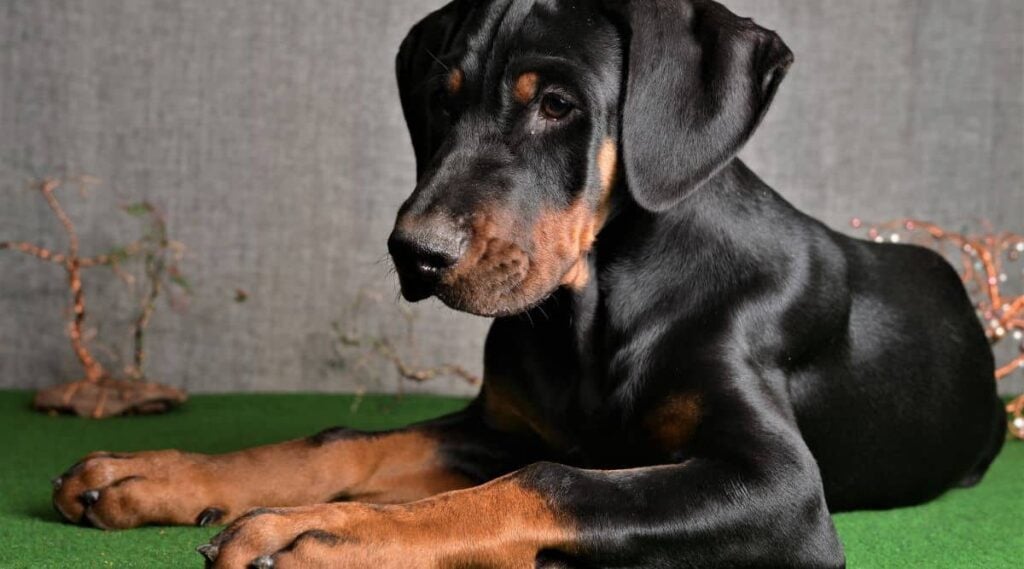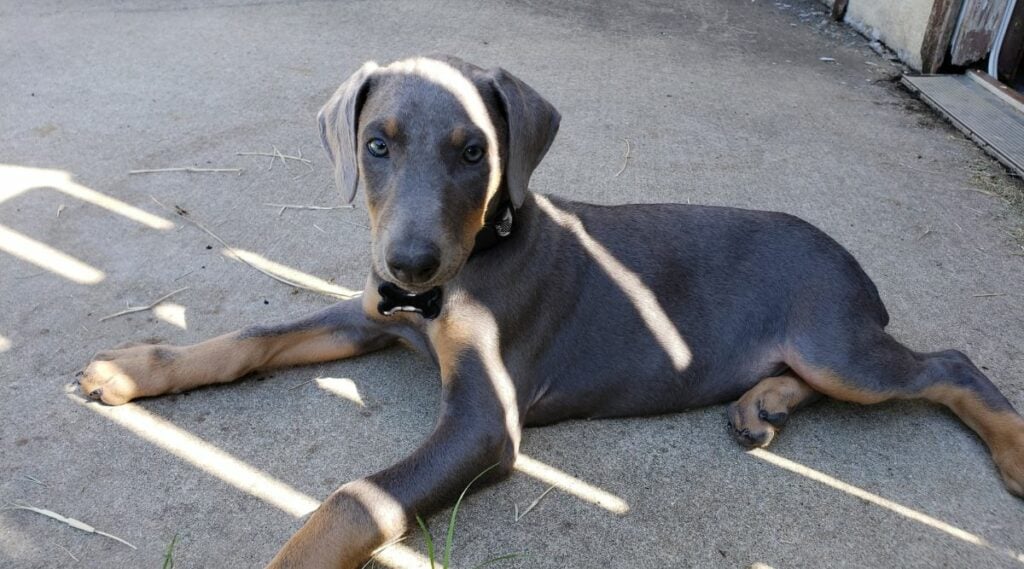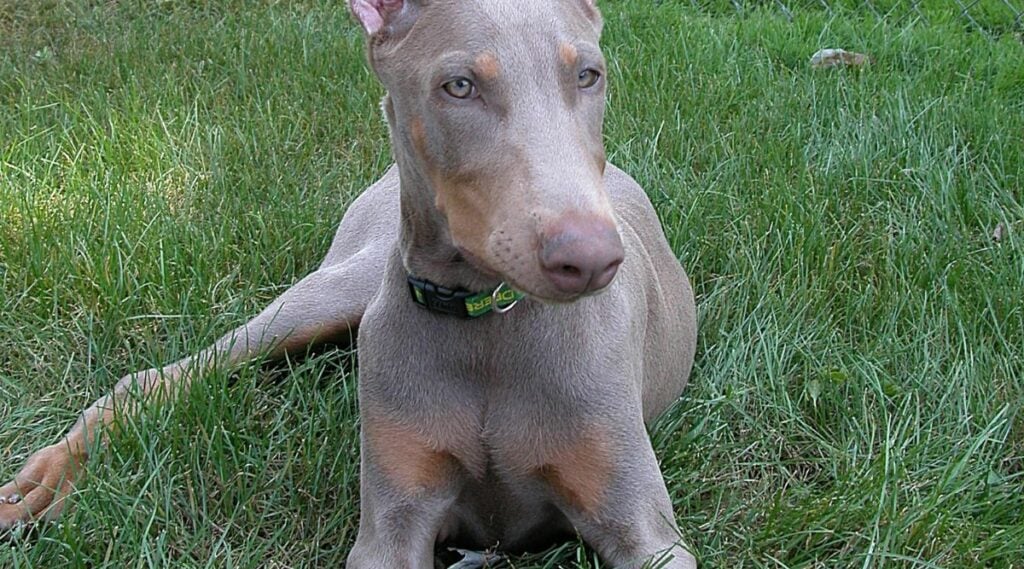Doberman Colors: 4 Breed Standards (And Other Variations)
When you purchase through links on our site, we may earn a commission. Here’s how it works.
According to the American Kennel Club (AKC), the Doberman Pinscher is one of America’s most popular dog breeds. They are brilliant guard dogs with a sweet, affectionate, family-friendly nature. They are adaptable, intelligent, loyal, fearless, surprisingly sensitive, and don’t like being alone. Dobermans are also prized for their formidable looks and soft, shiny coat, and this guide is dedicated to their coat.
Table of Contents
The Doberman’s coat is short, with thick, smooth hair, but what about their coat colors? According to the AKC breed standard, there are four standard colors. Some irresponsible breeders list their Dobies as rare colors and command a higher price. But unfortunately, outside of the four standard colors, these breeders are lying to you about their coloring or selling potentially unhealthy pups.
In this Doberman color guide, we look at the four standard American Doberman colors and the others that are not recognized. Plus, we have a section exploring the frequently asked questions, with other critical color-related issues, such as Doberman health and breeders. Let’s take a closer look.
Doberman Breed Standard
A dog’s breed standard is where the guidelines of a dog’s expected appearance and personality are officially demonstrated. If you want to show your Dobie in the show ring, their appearance must follow these guidelines. Different kennel clubs have different standards, but the leading kennel club in America is the AKC. The AKC’s Doberman Pinscher breed standard says the following about their color:
Allowed Colors – Black, red, blue, and fawn (Isabella). Markings – Rust, sharply defined, appearing above each eye and on muzzle, throat and forechest, on all legs and feet, and below tail. White patch on chest, not exceeding ½ square inch, permissible. Disqualifying Fault – Dogs not of an allowed color.
American Kennel Club
It’s also important to note that American and European Dobermans have slightly different color standards. The Federation Cynologique Internationale (FCI) is one of Europe’s primary kennel clubs, with slightly different appearance rules than America. The FCI states that there are only two true Dobie colors, and that is black or brown with red rust markings. Here in this color guide, we focus on the AKC Doberman colors.
Standard Doberman Colors
Here are the four standard and most common Doberman colors the AKC accepts.
Black & Rust

The black and rust coat color, sometimes known as the black and tan coat, is the most common and associated color with the breed. This color occurs in dogs carrying the black gene without the dilute gene. Their rust markings are clearly visible against the intense black background color.
Blue & Rust

The blue and rust coat occurs when the Dobie carries the black and dilute gene, resulting in a diluted black color. Anything non-vividly black is considered a blue coat, and you might hear Dobies with this coat referred to as Blue Dobies. The blue coat varies in shades from silver to charcoal gray, still with distinct rust markings.
Red & Rust

The red and rust coat color appears when the Doberman doesn’t carry dominant black or dilute genes. This is the second most common Dobie color, sometimes called brown or chocolate Dobies. The rust markings are harder to see, but they should still have distinct and visible markings.
Fawn & Rust

This is the last standard Dobie color, occurring when the dog carries a dominant dilute gene and a recessive black gene. Fawn and rust coats must still have defined markings, but the fawn coat is so light that the coat and marking colors appear to merge into one. Some breeders refer to this coat color as Isabella and rust, but Fawn and Isabella in this breed are essentially the same color.
Non-Standard Doberman Colors
Here we look at another color that appears in the breed and another two colors that don’t exist in a purebred Doberman. Let’s explore this further.
White/Albino
The AKC acknowledges that white exists in the breed and registers them, but it is not listed as a standard color. White Dobies are more cream than they are white, and they lack the usual rust markings. They are scarce, and the first registered white Doberman named Sheba appeared in 1976, born to black and rust parents. It is believed that all white Dobies are descendants of Sheba.
White Dobies have white to ivory markings, slightly different from the primary cream coat color. Because they have some pigmentation, in that they have cream coats and defined markings, and blue eyes, they are not true albinos who have no color whatsoever. For this reason, it is commonly agreed that they are “tyrosinase-positive albinoids,” which means they are on the albino spectrum.
The Doberman Pinscher Club of America (DPCA) has extensively studied white/albino Dobies and found that, like true albinos, the dogs in the study were more at risk of immunity diseases, neurological disorders, sensitive or cracked skin, skin cancer, photosensitivity, poor eyesight, unilateral or bilateral deafness, and more. They also found that they were hyperactive fear biters, likely partly due to their poor vision.
As a result, the DPCA has lobbied the AKC hard to eliminate white Dobies. Although the AKC still registers them, “Z-tracking” became available in 1998. This DNA test provides an identifier to enable breeders to recognize descendants of Sheba. This bid to eliminate the albinistic gene is a valuable tool for responsible breeders. Therefore, breeders with the Dobies’ best interests do not breed white specimens and spay/neuter them before selling them. Remember this when buying a puppy.
Black
In rare cases, the markings on some Dobies are so dark that they appear all black. However, if you look close enough, you can see that they have slightly different colored hair where their markings are usually visible. A renowned Doberman breeder, Holly Schorr, states that she has never seen an all-black Dobie in her 38 years as a breeder. So, if you come across a pure black Dobie, it isn’t a purebred Doberman.
Merle
The merle gene is not in the Doberman bloodline. However, you might have seen photos of merle-colored Dobies. If you have, it is because they are not true Dobermans and have been mixed with another dog breed that carries the merle gene, such as the Australian Shepherd or the Collie. Please avoid any breeder selling a merle-colored pup as a purebred Dobie because they are not responsible breeders and don’t care for the Doberman bloodline.
Frequently Asked Questions
What Color Doberman Should I Get?
This depends on what color you prefer. And it also depends on whether you want your Doberman for family companionship or to show or breed. If you’re seeking a family pet, any standard Dobie colors, with or without slight variations, are suitable. However, you should pick a Dobie pup based on their personality rather than color. But, if you’re looking to show or register and breed your Dobie, they must adhere to the strict guidelines set out by the AKC.
Does A Coat Color Affect A Dog’s Personality?
The only coat color that affects their personality is white/albino. Studies by the DPCA show that, although white Dobies are only partial albinos, they still have neurological disorders and display negative behavioral issues such as hyperactivity and fear aggression. Ultimately, you should avoid buying a white/albino pup if you want a true Dobie personality.
Are Some Doberman Coat Colors More Expensive Than Others?
Sometimes, but it depends on a whole range of factors, and responsible breeders shouldn’t increase or decrease prices too much based on color. Breeders selling companionship (non-working) Dobies might raise their prices for non-black and rust pups because there might be more demand for the rarer colors. At the same time, breeders might increase the cost of the most common black and rust color because it is the most desirable in some circles, such as in the ring or working environments. Unfortunately, there isn’t a clear-cut answer here.
How Do I Find A Responsible Doberman Breeder?
The best place to start your research for a responsible breeder is on the AKC’s Doberman breeder page. You should also research breeders online and conduct your due diligence. Meet up with them and their dogs, and look for independent reviews from other Dobie owners. If you get a bad feeling from a breeder, trust your gut and find another one. Working with a responsible breeder is crucial for finding a well-bred Doberman.
Final Thoughts
As you have learned, there are four true Doberman colors, black, blue, red, and fawn, all with rust markings. Some are rarer than others. The AKC does not accept white as a standard color, and it is a form of albinism that increases the risks of various health problems. And then there are photos of black and merle-colored Dobies circulating online, but these are not purebred Dobies. All Dobies are regal and handsome in their own way, no matter the color. But finding a responsible breeder who breeds for health, not looks and color, is essential.



